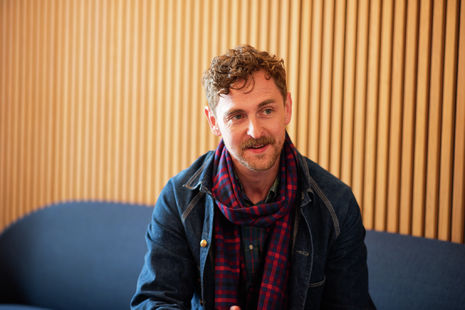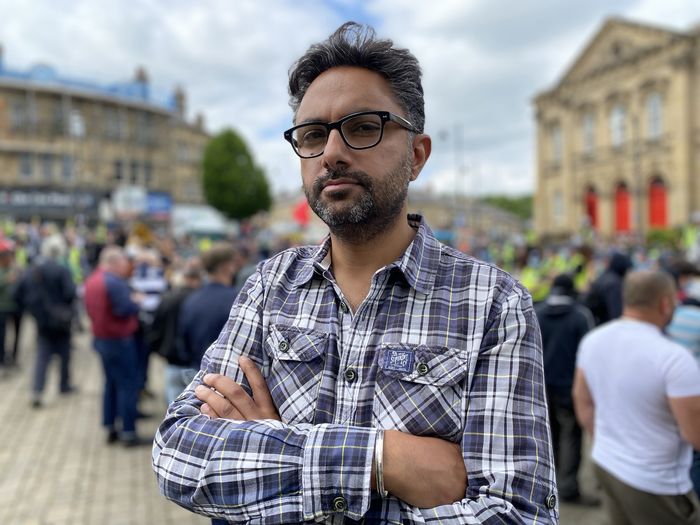Queering academia and beyond with Diarmuid Hester
Maddy Browne speaks to research fellow and ‘Club Urania’ founder about how we can build a queer space in Cambridge

“We’re trying to figure out how to live in straight society,” Diarmuid Hester tells me. The English research fellow and co-founder of ‘Club Urania’ is currently dedicating his life to challenging heteronormative ways of living; or, his life so far, as he reminds me. “I might be a gardener in ten years’ time, who knows?” he says between sips of coffee. Right now, he is sticking to the double denim uniform of the cool academic, and saving the gardening gloves for later.
Rather than pose for a photo, Hester opts to compliment my lucky-cat earrings while we try and get a candid shot. He tells me later that he is “very interested in the threshold where the concrete meets the abstract”. Perhaps queer culture can be viewed in such a way, where the funky earrings and the dyed hair and the keys-on-carabiners open up a world of endless possibilities, beyond any visible cultural markers. (Feel free to add your own to my very non-exhaustive list.)
For the people that Hester studies, living as a queer person in a heteronormative society, and the process of engaging with queer culture, is about reclaiming one’s own experience of the world. Hester also outlines his theory that “all of the work that you’re doing is somehow connected to you as an individual”. “If you’re researching sea slugs,” he jokingly adds, “there is something in your background” where studying sea slugs “fulfils a need”. Whether you’re studying molluscs or literature, there is something there that connects to you as a person, even subconsciously.
“We have to combine reality and theory, ‘concrete’ and ‘abstract’, to truly encompass the queerness of ‘real life’”
When it comes to his latest book, Nothing Ever Just Disappears, he tells me explicitly how it was “addressing a need”, by exploring “a desire to be rooted, as an Irish immigrant, [and] a queer immigrant”. The book travels from Cambridge to Paris to New York, following LGBTQ+ figures of the past such as E. M. Forster, Josephine Baker and James Baldwin. Media from and for marginalised people, he goes on to describe, “wasn’t beamed into living rooms of rural Ireland in the 1980s and 1990s”. He had to enrol on “the gay degree” at the University of Sussex to properly explore such queer media (and spend twelve years living in Brighton, of course.)
Having moved here in 2017, the shift from the queer spaces of Brighton to the not-quite-so-rainbow streets of Cambridge prompted Hester to co-found ‘Club Urania’. The group put on club nights with cabaret and drag, as well as day festivals. He laments that “there is a huge queer community in Cambridge, [but] there is no space where you can get to know people on a regular basis,” especially outside of the colleges. So, ‘Club Urania’ was designed to reach “a broader demographic”, where “you get people from seventeen to sixty” that attend, as well as those “who have never been inside a Cambridge college”.
“You have a certain kind of relationship to place which is very specific to you and to other people who have non-normative desires”
This “broader demographic” also encompasses additional layers of accessibility that the central Cambridge club scene is yet to catch up on. As Hester also told audience members in a LGBTQ+ Staff network event I attended back in February, ‘Cub Urania’ nights are wheelchair accessible and have captioning, a dedicated chill-out space, sensitivity checks and pay-what-you-feel tickets. He explains that normalising these access arrangements has been a “learning experience” for him. “If the tech is there, which it is, then why not make it available?”, he says – a question that is being asked more and more in marginalised spaces, as queer access intersects with disabled access. Only then can we make queer space, a true room (or pub, or club night) of one’s own.
Hester is trying to do just that. On this particular occasion, this means talking about queer theory in Newnham café. But what makes a space queer? Somewhere “where a community can convene in safety”, he answers. For Hester, this is only the tip of the iceberg: “I’m not really so much interested in queer spaces, as what a queer sense of place is”. “When you grow up in that kind of context,” from southeast Ireland to Cambridge to heteronormative societies across the world, “you have a certain kind of relationship to place which is very specific to you and to other people who have non-normative desires.”
Queer space, then, is what we make it. The same of which can be applied to academia, and carving out theories and philosophies that actually connect to “the life, the language, the real concerns of queer people and actually existing communities”. Hester fills me in on how in the 1990s and 2000s, this “connection got a little bit frayed”, despite the fact that queer studies and queer theory had come out of contemporary generations of queer activists. Thankfully, he reminds me that “there are reasons to be optimistic”.
Repairing this connection can start with what we choose to study and what media we consume, to honour that “queer sense of place”, inside and outside of the library. Hester recalls one of his past students who “had wanted to write about drag performance and literary experimentation, and I said ‘Have you ever been to a drag show? ’ and she said ‘No’”. “What I did was I sent her off to a drag show,” he says, smiling, “to write about that experience [and] think about how the work you’re doing relates to real life”. We have to combine reality and theory, “concrete” and “abstract”, to truly encompass the queerness of “real life”. This of course means that we can all go and see a drag show instead of revising.
 News / Eight Cambridge researchers awarded €17m in ERC research grants27 December 2025
News / Eight Cambridge researchers awarded €17m in ERC research grants27 December 2025 News / Downing investigates ‘mysterious’ underground burial vault 29 December 2025
News / Downing investigates ‘mysterious’ underground burial vault 29 December 2025 Lifestyle / Ask Auntie Alice29 December 2025
Lifestyle / Ask Auntie Alice29 December 2025 Sport / Hard work, heartbreak and hope: international gymnast Maddie Marshall’s journey 29 December 2025
Sport / Hard work, heartbreak and hope: international gymnast Maddie Marshall’s journey 29 December 2025 Interviews / Meet Juan Michel, Cambridge’s multilingual musician29 December 2025
Interviews / Meet Juan Michel, Cambridge’s multilingual musician29 December 2025










